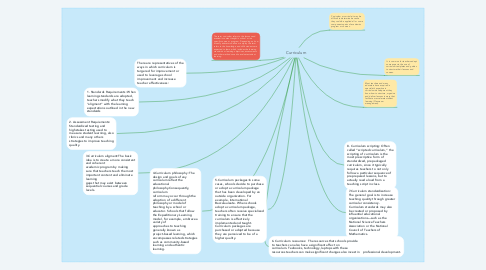Curriculum
by Paola Lobo Varela

1. The term curriculum refers to the lessons and academic content taught in school or in a specific course or program. Depending on how broadly educators define or employ the term refers to the knowledge and skills students are expected to learn, which includes the learning standards or learning objectives, assessments and other methods used to evaluate student learning.
2. There are representatives of the ways in which curriculum is targered for improvement or used to leverage school improvement and increase teacher effectiveness:
3. 1. Standards Requirements: When learning standards are adopted, teachers modify what they teach "aligment" with the learning expectations outlined in the new standards
4. 2. Assessment Requiements: Standardized testing and highstakes testing used to measure student learning, also ribrics and many others strategies to improve teaching quality.
5. 3.Curriculum aligment:The basic idea is to create a more consistent and coherent academic program by making sure that teachers teach the most important content and eliminate learning gaps that may exist between sequential courses and grade levels.
6. 4.Curriculum philosophy: The design and goals of any curriculum reflect the educational philosophy.Consequently, curriculum reform may occur through the adoption of a different philosophy or model of teaching by a school or educator. Schools that follow the Expeditionary Learning model, for example, embrace a variety of approaches to teaching generally known as project-based learning, which encompasses related strategies such as community-based learning and authentic learning.
7. 5.Curriculum packages:In some cases, schools decide to purchase or adopt a curriculum package that has been developed by an outside organization. For example, International Baccalaureate. When schools adopt a curriculum package, teachers often receive specialized training to ensure that the curriculum is effectively implemented and taught. Curriculum packages are purchased or adopted because they are perceived to be of a higher quality.
8. 6. Curriculum resources: The resources that schools provide to teachers can also have a significant affect on curriculum. Texbooks, technology, laptops with these resources teachers can make significant changes also invest in professional development.
9. Curriculum or curricula it may be difficult to determine because they could be applied all or some components parts of academics program or courses.
10. It is common for teachers adapt some aspects, the use of curriculum templates and guides to structure their lessons and courses.
11. Most teachers and many educators have acquired a specialist’s expertise in curriculum development they know how to structure, organize and deliver lessons in ways that facilitate or accelerate student learning (Classroom management).
12. 7.Curriculum standardization: The general goal is to increase teaching quality through greater curricular consistency. Curriculum standards may also be created or proposed by influential educational organizations—such as the National Science Teachers Association or the National Council of Teachers of Mathematics.
13. 8. Curriculum scripting: Often called “scripted curriculum,” the scripting of curriculum is the most prescriptive form of standardized, prepackaged curriculum, since it typically requires teachers to not only follow a particular sequence of preprepared lessons, but to actually read aloud from a teaching script in class.


